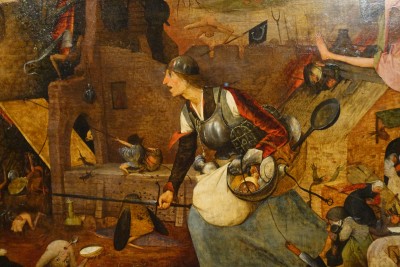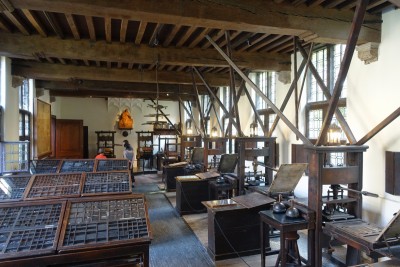Lively and Affluent Antwerp
(vero;2023-Nov-13)
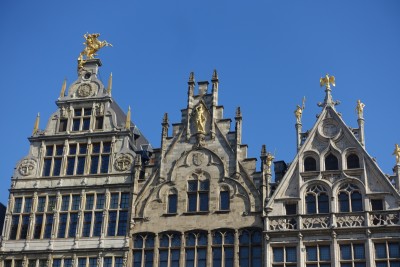 There is a lot to see in Antwerp. The city is located on the banks of the river Scheldt (Escaut in French) before it flows into the North Sea and is the first port of the country making it a very important economic hub in Belgium and Europe. Through its long history, Antwerp has always been a cosmopolite city, driven by trade and open to other cultures. It is of course also known as a global centre for the diamond trade.
There is a lot to see in Antwerp. The city is located on the banks of the river Scheldt (Escaut in French) before it flows into the North Sea and is the first port of the country making it a very important economic hub in Belgium and Europe. Through its long history, Antwerp has always been a cosmopolite city, driven by trade and open to other cultures. It is of course also known as a global centre for the diamond trade.
Over the centuries the city has been home to prominent painters, humanists and patrons of the art, it was the centre of Flemish Renaissance Painting in the 16th and 17th centuries. This reflects in the wealth of treasures exhibited in the diverse art museums of the city.
We had a full programme during the three days we spent in Antwerp. Aside from the usual strolling, we visited many museums, some of them providing interesting glimpses in the history and activities of the city: the Red Line Museum featuring Antwerp as a city from which many departed for a new life in America, the MAS projecting the history of Antwerp and its connections to the world, DIVA for all those diamonds to name just a few. But from all museums we saw, the best were undoubtedly the Mayer van den Bergh and Snijders & Rockox museums for paintings, Plantin-Moretus for a plunge into the period of the Renaissance through the life, work and legacy of a reputed humanist. And of course the KMSKA is not to be missed, the obligatory Museum of Fine Arts of Antwerp. The Rubenshuis Museum was unfortunately closed for major renovation works; it is due to re-open in June 2027.
But it's not all, although heavily bombed in WWII, Antwerp has retained many grand houses from its rich past and the city offers today an interesting mix of old and new, its architecture spanning from the Gothic and Renaissance periods to the monumental Centraal Station and impressive modern buildings such as the MAS (Museum aan de Stroom) in the north of town.
Practicalities
We were based in the city of Dendermonde, quite in the centre of a triangle Ghent-Antwerp-Brussels. We visited Antwerp three times, driving north to the E17/A14 motorway which approaches the city from the west. We parked for 1€ per day (24 hours) at the Park & Ride Linkeroever a huge and very convenient car park building with direct access to frequent trams and buses into the city centre. An advantage of this P+R is that the motorway exit (no 17) to access it is just before the usual traffic jams into the city begin: we never got stuck. Prices for public transport as per September 2023: 2.50€ for a single ticket (5€ return). You can also buy a carnet of 10 tickets for 17€.
Beware: Antwerp has a LEZ (Low Emission Zone). If you are a foreigner and have a number plate from a country other than Belgium or Netherlands, you MUST register your vehicle (for free) if you think you will enter the zone during your stay. To do this, go to this website, to check if your vehicle is OK and to register.
The entry fees for museums and some monuments are quite high and we recommend buying either the Antwerp City Pass for 45€/24hr, 55€/48h or 65€/72h (consecutive days including public transport) if you plan to visit more than one or two of them or even best if you plan to visit more than one city in Belgium, the Belgian Museum Pass for 59€ valid for one year (not including all museums though, so make sure that the ones you want to see are included, search this page by city). Prices were valid at our time of visit in September 2023; the Antwerp city pass can be purchased at the visitor centres located at Het Steen or at the Centraal Station, the Belgian Museum Pass can be purchased online or at a participating museum. Don't forget to check the opening times before setting off: many museums are closed on Mondays (but not all).
Do not forget to check our photo gallery dedicated to Antwerp to discover views of the city and have a peek inside some of our preferred museums. We have prepared a short description of the best to whet your appetite below:
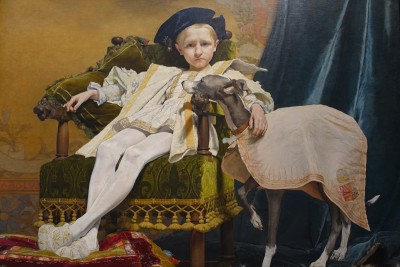
KMSKA - Museum of Fine Arts: the KMSKA (Koninklijk Museum voor Schone Kunsten Antwerpen) was founded in 1810 and houses a collection of paintings, sculptures and drawings ranging from the 14th to the 20th centuries.
Re-opened after extensive renovation in September 2022 it has (like the MSK in Ghent) introduced a new way of presenting the numerous exhibits by interrupting the chronological suite of rooms with rooms dedicated to a certain theme mixing works from different periods in doing so.
Click here for practical information on opening hours and prices of the museum. Note that this museum is open daily, one of the few to be opened on Mondays.
Don't forget to check our photo gallery dedicated to this museum.
Mayer van den Bergh Museum: we enjoyed this museum so much that we visited it twice. It is home to the art collection of Fritz Mayer van den Bergh (1858-1901): raised in a wealthy family he invested his fortune in art and spent the most of twenty years buying art and historical objects. His interests were wide-ranging and you'll discover more than paintings while visiting the museum: he collected also sculptures, coins, prints and drawings.
His dream was to create a museum for his collection but he died too early aged 43 in a riding accident. So it was his mother after his death who set out to make it into reality: in just three years she had a house built solely for this purpose in the centre of Antwerp and had the place furnished specially to receive the collection. She acted as curator of the collection until her death.
Click here for practical information on opening hours and prices of the museum. Note that this museum is closed on Mondays.
The museum highlight is undoubtedly the painting of Dulle Griet (Mad Meg) by Pieter (I) Bruegel (shown on the right). Don't forget to check our photo gallery dedicated to this museum.
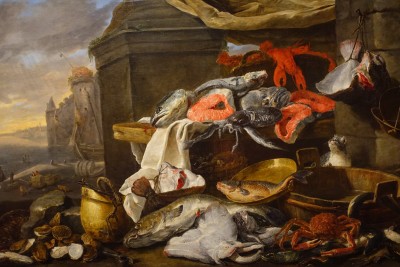
Snijders & Rockox: introduce Frans Snijders, a painter renowned for his still lifes and paintings of animals, and Nicolaas Rockox, an affluent political man (he was mayor of Antwerp), collector and patron of the arts. Both lived their adulthood in Antwerp at the beginning of the 17th century and were part of the fertile art society of the time which included the likes of Cornelis de Vos, Jacques Jordaens the Elder, Peter Paul Rubens, the latter being a close friend and protégé of Nicolaas Rockox.
Frans and Nicolaas were neighbours and the museum is located in their former houses now propriety of KBC (a Belgian bank and insurer) who renovated and linked them in order to host the bank's collection of Old Masters (plus some loans from museums and private collections).
Click here for practical information on opening hours and prices of the museum. Note that this museum is closed on Mondays.
Don't forget to check our photo gallery dedicated to this museum.
Museum Plantin Moretus: this museum is a treasure trove for everything related to printing and publishing; it is located in the former residence and printing press of the Plantin-Moretus family and filled with prints, old folios, first editions, atlantes and maps, putting into perspective the primordial role of the Plantin-Moretuses in the propagation of knowledge and the development of typography, giving an insight into the vibrant intellectual time of the Renaissance.
The museum is home to the two oldest surviving printing presses in the world with complete sets of letter punches and matrices, it also has an extensive library, a richly decorated interior (with many paintings by Peter Paul Rubens) and the entire archives of the Plantin business.
Click here for practical information on opening hours and prices of the museum. Note that this museum is closed on Mondays.
Don't forget to check our photo gallery dedicated to this museum.
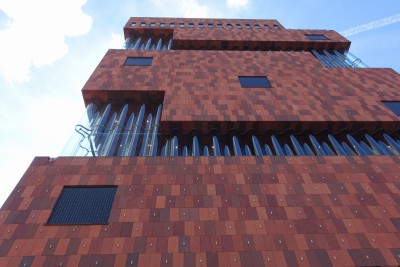
MAS Museum aan den Stroom: even if you don't have much time, we strongly recommend making your way to the Museum an den Stroom (MAS) just for the sake of its architecture and the panorama view of the city you can have from its roof terrace. The aim of this museum is to present Antwerp and its connections to the rest of the world in the past and the present, I would broadly call it a City Museum.
Each floor has its own hall of exhibition and there is a lot to see. The second and third floors host temporary exhibitions while floors four to eight are home to the permanent collection.
We visited three of them: floor six dedicated to "Freight" and the port activities, floor five named "à la carte" which we found disappointing (we expected maps, it was all about food!) and finally floor four with the self-explanatory title "City at War" (WWII).
Click here for tickets and rates, the access to the roof terrace is free of charge. Note that this museum is closed on Mondays.
Want to read more? Go back to Friendly and Engaging Ghent or go up to Blog
$ updated from: Blog.htxt Mon 28 Apr 2025 14:55:37 trvl2 — Copyright © 2025 Vero and Thomas Lauer unless otherwise stated | All rights reserved $




